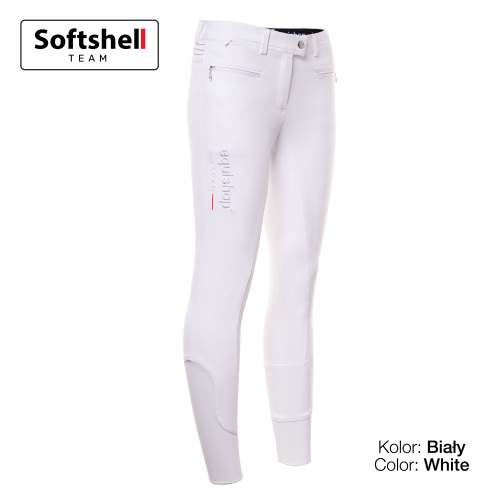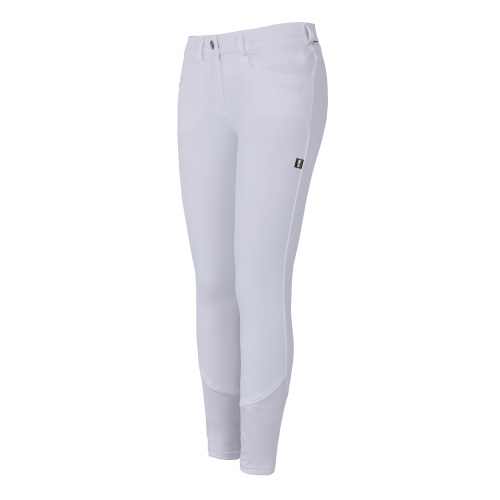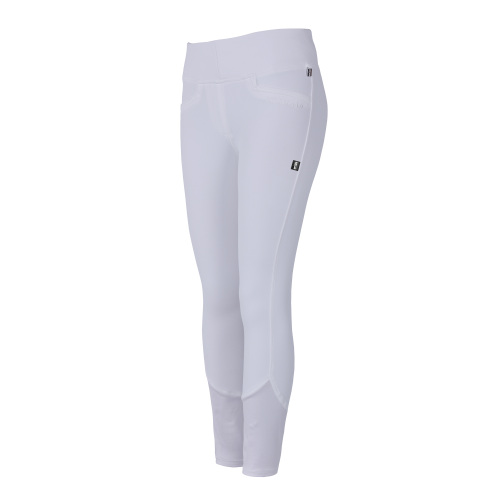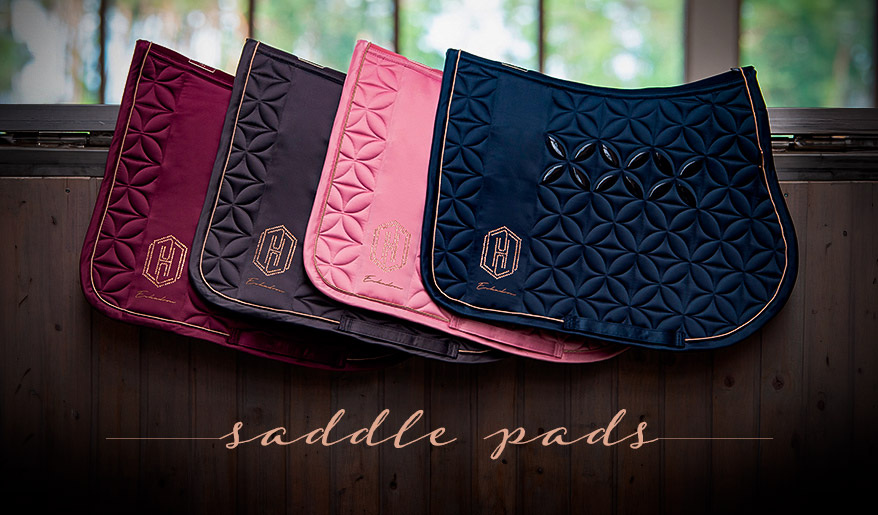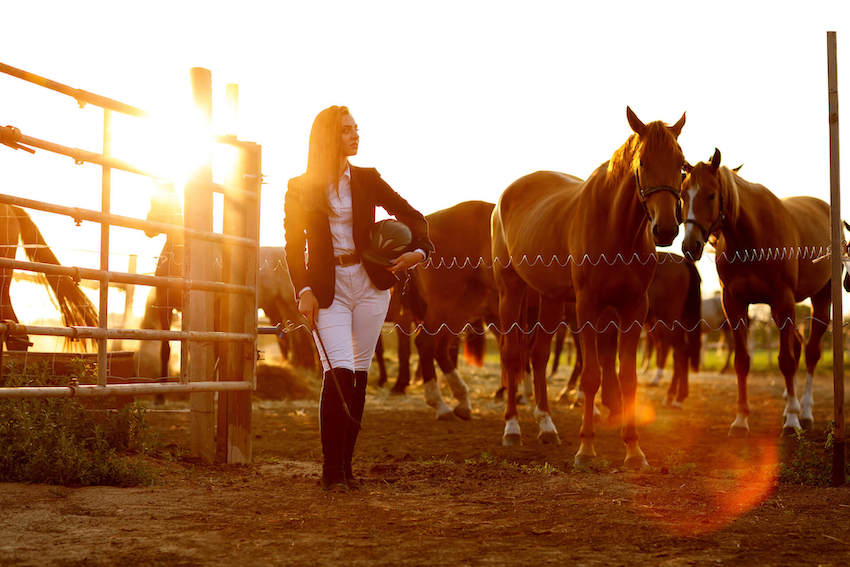
1. Reithose – was ist das genau?
Ein untrennbarer Bestandteil der Kleidung eines jeden Reiters sind Reithosen (Breeches - das Wort bedeutete ursprünglich im Englischen Hosen, die unterhalb des Knies oder der Mitte der Wade enden), spezielle Hoden zum Reiten, die Bewegungsfreiheit und richtigen Sitz ermöglichen. Sie zeichnen sich durch das Fehlen von Nähten an der Innenseite des Beins aus, wo die Beine des Reiters den Sattel oder das Pferd berühren - diese Lösung verhindert Abschürfungen und sorgt für Komfort beim Reiten. Heutzutage bieten die Reitsportgeschäfte eine sehr große Auswahl dieser Art von Reithosen an - von dünnen Sommerreitleggings über elegante Turniermodelle bis hin zu Reithosen für besondere Aufgaben aus technischen Geweben der neuesten Generation. Frauen- oder Herrenreithosen haben eine ebenso reiche Geschichte – wie die meisten Reitsportartikel verdanken wir unsere Reithosen der Militäruniform.
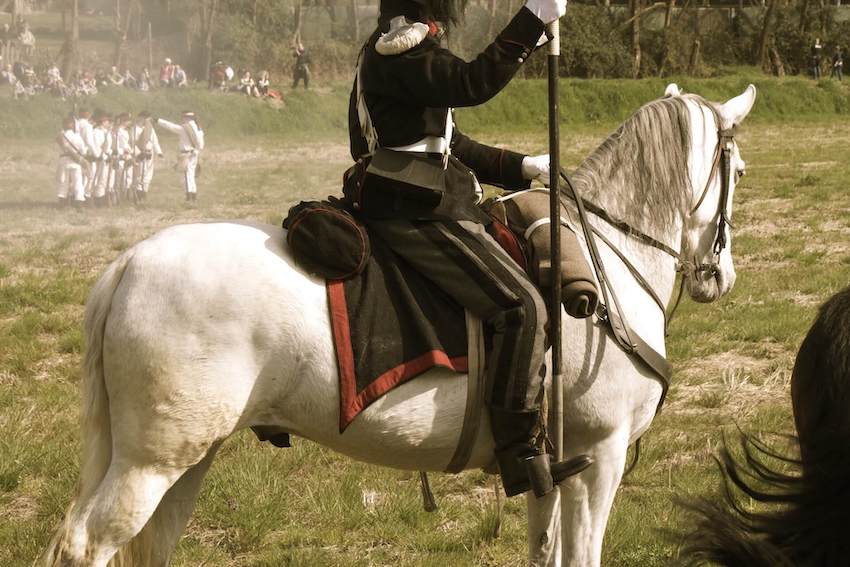
2. Geschichte der Reithose
Zeitgenössische Reithosen mit Vollbesatz ähneln am ehesten einer Strumpfhose (deutsch: Reithose, Hose zum Reiten - nicht zu verwechseln mit einem modernen Element der Frauenbekleidung!) - enge, mit Kalbsleder ausgekleidete Hosen wurden vor allem im 19. Jahrhundert von verschiedenen Armeen getragen. In Polen waren sie am Ende der Ersten Polnischen Republik Teil der Uniformen der Nationalkavallerie sowie der Ulanen und Kavalleriesoldaten in napoleonischer Zeit. Eine besonders knappe Art von Strumpfhosen waren Pantalons, die einige Zeit als "polnische Kleidung" bezeichnet wurden, dann in leicht modifizierter Version Teil der Frauenunterwäsche wurden. Der napoleonischen Armee verdanken wir nicht nur die Reithose – ihre Uniformen prägten maßgeblich die Reitbekleidung. Sie wurde so erstellt, damit man bei Feldzügen lange Stunden im Sattel verbringen konnte, in Farben, die noch heute auch auf den Parkours und Vierecken vorherrschen - weiß, marineblau, rot, mit Frack und schmaler Reiterhose. Die sogenannte Kavallerie-Reithose mit charakteristischem Schnitt: Das Bein wird im Oberschenkelbereich über dem Knie breiter, wodurch ein charakteristischer "Puff" entsteht. Dieser Hosenschnitt findet man in den Uniformen der im Ersten Weltkrieg dienenden Kavallerieeinheiten - der letzte Krieg, dessen Verlauf von Pferden und Pferdeeinheiten beeinflusst wurde. Es war auch der letzte Krieg, in dem Armeen (zumindest am Anfang) bunte, verzierte Uniformen trugen. Die im oberen Teil verlängerte Kavalleriehose ging mit dem Bedeutungsverlust der Pferdetruppen nicht aus der Verwendung - sie wurde während und nach dem Zweiten Weltkrieg in Uniformen verwendet. Obwohl sie bei "normalen" Reitern weniger beliebt ist, wurde sie Teil der Uniform von Kavallerie-Rekonstruktionsgruppen und Ulan-Regimentern. Wettkämpfer, die berechtigt sind, während des Wettkampfs Uniformen zu tragen, wie z.B. die mehrfache Medaillengewinnerin Żaneta Skowrońska, wählen eher schmale Modelle.
3. Reithosenschnitte und ihre Arten
Die Beliebtheit des schmalen Hosenbeinschnitts, sowohl bei Frauen- als auch bei Herrenreithosen, hängt mit der Bequemlichkeit und Praktikabilität dieser Lösung zusammen. Der enganliegende Schnitt sowie das Fehlen von Nähten an den Beininnenseiten schützen vor Abschürfungen. Während des Reitens rollt oder bewegt sich das Material nicht und bietet dem Reiter Komfort in jeder Gangart. Darüber hinaus erleichtern schmale Hosenbeine in der Wade die Passform und das Anziehen von Reitstiefeln oder Stiefeletten. Reiter sind jedoch nicht nur zu engen Reithosen mit Silikon- oder Lederbesatz verdammt – im Verkauf gibt es auch die sogenannten Breeches, ähnlich der Kavalleriehose im Schnitt, aber im oberen Hosenbeinbereich verbreitert - allerdings nicht so aufgebauscht wie die Uniformhose der Ulanen. Ein weiteres Modell von Reithosen, die nicht über das gesamte Bein eng anliegen, sind Jodhpur-Hosen. Ihr Name stammt von der Stadt Jodhpur in Indien, und ihr Schnitt ist von traditionellen indischen Reithosen namens Churidar inspiriert. Diese Art von Hosen wurde Ende des 19. Jahrhunderts in Großbritannien populär, als Maharaja Jodhpurs Sohn sie mit seinem Polo Team während des diamantenen Thronjubiläums von Königin Victoria aufführte. Derzeitig haben Reithosen gerade oder leicht ausgestellte Beine und ermöglichen durch ihren Schnitt und die Verstärkungen an der Innenseite das Reiten ohne Gamaschen. Beim Reithosenreiten werden kurze Reitstiefel verwendet. Bei der Suche nach weniger populären Reithosen-Schnitten muss man geduldig sein – der Markt wird dominiert von schmalen, eng anliegenden Reithosen, die ständig verbessert und modifiziert werden, um den Komfort der Reiter zu erhöhen.
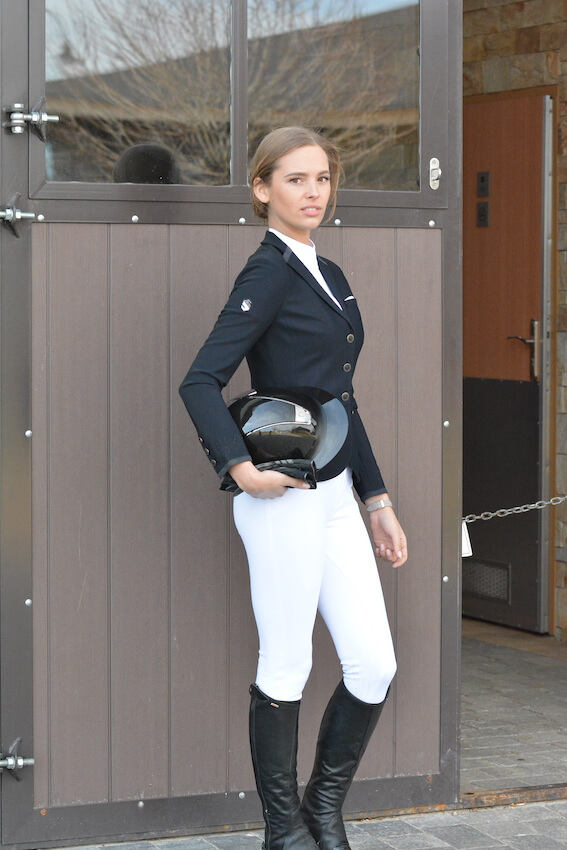
4. Reithosenbesatz
Heutzutage können wir aus der großen Vielfalt an Reithosen auf dem Markt auswählen. Was sollte man bei der Auswahl beachten? Wie unterscheiden sich die individuellen Schnitte und technologischen Lösungen? Der grundlegende Unterschied zwischen modernen Reithosen ist die Besatz Art. Der Besatz ist eine zusätzliche Verstärkung an der Innenseite des Beins, die an Stellen genäht wird, an denen der Körper des Reiters eng am Sattel anliegt. Die Aufgabe des Besatzes besteht darin, die Haftung am Sattel zu verbessern, sowie das Material an Stellen zu verstärken, an denen es durch intensive Nutzung schneller beschädigt werden könnte. Diese Art der Verstärkung aus Kalbsleder wurde in die Hosen der Kavalleriesoldaten eingenäht. Anfangs waren die Besätze auch bei "zivilen" Reithosen aus glattem Leder oder Sämischleder, aber sie waren schwer zum Pflegen - nach dem Waschen waren die Lederbesätze steif, deformiert und schwer in gutem Zustand zu halten. Nach und nach ersetzten traditionelle Lederbesätze Besätze aus künstlichen Stoffen, Kunstleder oder Sämischleder. Ihr Vorteil war, dass sie leicht sauber zu halten waren, sie bieten einen ebenso guten Grip wie Leder, aber sind nicht so haltbar. Einige der synthetischen Materialien haben ihren Job nicht sehr gut gemacht, anstatt die Hose an wichtigen Stellen zu verstärken - waren sie die ersten, die kaputt gingen. Das neueste Material, das derzeitig den Markt dominiert, ist Silikon, meist in Form eines kleinen Aufdrucks anstelle von traditionellen Leder- oder Kunststoff Patches. Silikon bietet eine hervorragende Haftung und dank der verbesserten Technologie mit dem Auftragen auf hoch taillierte Reithosen, fällt es nicht ab und zerbröckelt nicht und behält seine Eigenschaften für lange Zeit. Silikondrucke gibt es in allen möglichen Formen: von den einfachsten Punkten und Streifen bis hin zu ziemlich raffinierten Mustern - ausgefallene Linien-Schnörkel, Miniaturtrensen oder Hufeisen sowie Sterne, Punkte, Blumen, Karos - die Art des Musters spielt keine Rolle bei der Hosennutzung während des Reitens, und ist nur ein dekoratives Element, angepasst an unsere Vorlieben und nur durch die Kreativität des Herstellers begrenzt.

1.Pikeur Tessa Grip Frauenreithose mit Vollbesatz
2. HKM Santa Rosa Pam Function Frauenreithose mit Silikonvollbesatz
- Kniebesatz oder Vollbesatz?
Neben der Materialart, aus dem die Reithose besteht, ist auch ihre Typ wichtig. Es gibt zwei Arten von Besätzen - Knie und Voll. Kniebesätze befinden sich, wie der Name schon sagt, nur an der Innenseite des Beins, auf Kniehöhe, in Form eines Leder- oder Kunststoff Patches oder eines Silikondrucks. Der Vollbesatz deckt die gesamte Innen- und Unterseite der Reithose ab – überall dort, wo der Körper des Reiters bei vollem Sitz am Sattel anliegt. Sowohl Knie- als auch Vollbesatz besteht aus traditionellen Materialien und Silikon. Die Wahl des Besatzes hängt von den Vorlieben, der Disziplin oder dem Reitstil des Reiters ab. Der Vollbesatz bietet besseren Halt, weshalb er häufiger von Dressurreitern gewählt wird, die hauptsächlich im Vollbesatz reiten. Auch für Anfänger, die gerade lernen, im Sattel zu balancieren und richtig zu sitzen, ist diese Art von Besatz hilfreich – dank gutem Halt auf größerer Fläche fällt es leichter, im Sattel zu bleiben. Auf der anderen Seite wird der Kniebesatz von Springreitern gerne gewählt: Er „hält nicht so fest im Sattel“ wie der Vollbesatz, aber gleichzeitig bietet in der für das Reiten sehr wichtigen Knieposition im Halbsitz und beim Sprung guten Halt.
Egal ob Frauenreithosen mit Vollbesatz oder Herrenreithosen, sie sollten oberhalb des Knöchels enden und an dieser Stelle eng anliegen, damit sie sich nicht einrollen und den Reiter stören. Daher wurden ältere Modelle mit einem Klettverschluss am Knöchel abgeschlossen, wodurch die Hosenbeinweite reguliert und die Kniestrümpfe bequem angezogen werden können. Bei neueren Modellen wird der Klettverschluss durch einen dünnen, elastischen Stoff ersetzt, der sich dem Hosenbeinumfang des Reiters anpasst, was auch die Hosenwahl nach Körpergröße erleichtert – das überschüssige Material, das sich bei niedrigeren Reitern ansammelt, wird nicht rollen, und größeren Menschen wird dies ein bisschen "Reserve" geben.

- Reithosenfarben. Welche Farbe soll man wählen?
Meistens sind Reithosen für Kinder und Erwachsene in dunklen, schlichten Farben erhältlich – wer einmal ein Reittier nach einem Schlammbad gereinigt hat, wird verstehen, warum es so ist... Allerdings gleicht Reitbekleidung längst nicht mehr einer Uniform, und die Hersteller von Bekleidung und Ausrüstung greifen eifrig zu kräftigeren Farben und Mustern. Traditionelles Schwarz, Marineblau, Dunkelgrün und Grau, obwohl immer noch beliebt und im Angebot aller Marken verfügbar, werden langsam durch immer interessantere Farben ersetzt. Was sollte man bei der Farbwahl von Reithosen beachten? Zunächst einmal den Anlass – wenn Sie eine Reithose für einen Wettkampf suchen, wählen Sie weiße oder cremefarbene Reithosen, die zum Wettkampfoutfit gehören. Unter Stallbedingungen sind weiße Reithosen für Frauen und Herren natürlich nicht sehr praktisch (ebenso wie weiße Schabracken), daher ist es besser, für den Alltag etwas dunklere Farben zu wählen. Im Angebot an gemusterten Reithosen ist ein traditionelles, elegantes Karo nur eine der Möglichkeiten – es gibt immer mehr, besonders bei Jugend- und Kinderreithosen, fröhliche und bunte Modelle. Neben Farbe und Muster ist auch die Materialwahl wichtig. Immer beliebter werden Jeansreithosen, oft mit einer Beimischung von Elasthan, wodurch die Hose am Körper anliegt. Für den Sommer lohnt es sich, Modelle aus dünneren Stoffen und in helleren Farben zu wählen, und für eine Hitzewelle können Sie dünne Reitleggings ausprobieren. In den kälteren Monaten hingegen lohnt es sich, nach Reithosen aus technischen Stoffen Ausschau zu halten – z.B. aus Softshell, das nicht nur warm, sondern auch wind- und wasserdicht ist, werden nicht nur Reiter, sondern auch Trainer, die stundenlang in der Halle stehen, zu schätzen wissen.
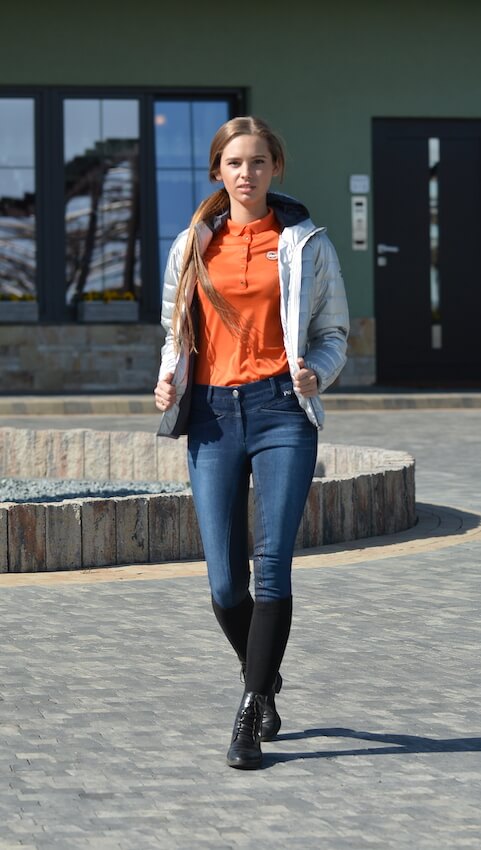
1. Pikeur Elfa Jeans Frauenreithose mit Silikonvollbesatz
Reithosen, obwohl sie früher Teil einer Militäruniform waren, ähneln heute nicht mehr den Strumpfhosen oder Pantalons des 19. Jahrhunderts. Die beliebtesten, schmalen Modelle werden von den Herstellern ständig verbessert und modernisiert, um das Reiten einfacher und angenehmer zu machen, mit schwierigen und wechselnden Wetterbedingungen fertig zu werden, aber auch um verschiedene Geschmäcker zu treffen – das Angebot ist so breit und vielfältig, dass sicher jeder fündig wird.
Suchen Sie eine Reithose, die Ihren Ansprüchen gerecht wird? Sehen Sie sich unser Angebot im Reitshop Equishop an: Reithosen, Schabracken, Reitstiefel.
Neuigkeiten von Equishop finden Sie in:









